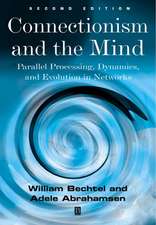The Semantic Representation of Natural Language: Bloomsbury Studies in Theoretical Linguistics
Autor Michael Levison, Greg Lessard, Craig Thomas, Matthew Donalden Limba Engleză Paperback – 25 iun 2014
| Toate formatele și edițiile | Preț | Express |
|---|---|---|
| Paperback (1) | 257.76 lei 43-57 zile | |
| Bloomsbury Publishing – 25 iun 2014 | 257.76 lei 43-57 zile | |
| Hardback (1) | 1008.01 lei 43-57 zile | |
| Bloomsbury Publishing – 19 dec 2012 | 1008.01 lei 43-57 zile |
Preț: 257.76 lei
Preț vechi: 295.53 lei
-13% Nou
Puncte Express: 387
Preț estimativ în valută:
49.32€ • 51.63$ • 40.81£
49.32€ • 51.63$ • 40.81£
Carte tipărită la comandă
Livrare economică 07-21 aprilie
Preluare comenzi: 021 569.72.76
Specificații
ISBN-13: 9781472576569
ISBN-10: 147257656X
Pagini: 352
Dimensiuni: 156 x 234 x 14 mm
Greutate: 0.38 kg
Editura: Bloomsbury Publishing
Colecția Bloomsbury Academic
Seria Bloomsbury Studies in Theoretical Linguistics
Locul publicării:London, United Kingdom
ISBN-10: 147257656X
Pagini: 352
Dimensiuni: 156 x 234 x 14 mm
Greutate: 0.38 kg
Editura: Bloomsbury Publishing
Colecția Bloomsbury Academic
Seria Bloomsbury Studies in Theoretical Linguistics
Locul publicării:London, United Kingdom
Caracteristici
Posits
onomasiological
(top-down)
framework
with
meaning
at
its
core
and
linguistic
realization
secondary.
Notă biografică
Michael
Levisonis
a
Professor
Emeritus
in
the
School
of
Computing
at
Queen's
University,Canada.Greg
Lessardis
a
Professor
in
the
Department
of
French
Studies
at
Queen's
University,
Canada.Craig
Thomasearned
his
PhD
from
the
School
of
Computing
at
Queen's
University,
Canada,
in2010
under
the
supervision
of
Michael
Levison
and
Greg
Lessard.Matthew
Donaldearned
his
MSc
from
the
School
of
Computing
at
Queen's
University,
Canada,
in2006
under
the
direction
of
Michael
Levison
and
Greg
Lessard.
Cuprins
List
of
FiguresList
of
TablesPrefaceTypographical
Conventions1.
Introduction2.
Basic
Concepts3.
Previous
Approaches4.
Semantic
Expressions:
Introduction5.
Formal
Issues6.
Semantic
Expressions:
Basic
Features7.
Advanced
Features8.
Applications:
Capture9.
Three
Little
Pigs10.
Applications
CreationBibliographyIndex
Recenzii
Levison
et
al.
present
a
useful
meaning
representation
framework
...
superior
in
both
human-readability
(especially
by
non-specialists)
and
in
its
representation
of
discourse
structures
beyond
the
sentence-level.
These
are
important
features
and
...
contribute
to
the
greater
usefulness
of
this
framework
for
non-computational
linguists.
[This book] provides a practical formal representation of the meaning of expressions of natural language, from basic semantic units to texts, which, commendably, relies closely on recent results within various contemporary theories and applications within lexical semantics, such as componential analysis, conceptual structures ... as well as various truth-conditional approaches to sentence meaning.
At last a book on natural language semantics that tackles semantics all the way up to texts of considerable length and fictional statements. The proposed formalism brings together well tried solutions for specific linguistic phenomena with a structural approach based on programming languages that makes it user friendly and gives it tremendous expressive power. A very useful contribution for natural language generation and the representation of narrative.
Semantic Representations of Natural Languageprovides a highly suggestive survey of the multiple relationships between semantic analysis and computational formalization of natural language and narratives, offering a vivid, nearly kaleidoscopic, theoretically comprehensive and strongly argued synthesis of a long lasting team approach. Even literature researchers concerned with the digital analysis of textuality will read this monograph with the greatest interest.
Genuine interdisciplinary research between linguistics, literary studies and computational approaches is rare. The research detailed here is an example of such interdisciplinary collaboration at its best. Technical, but enjoyable, this is a book to be read and thought about as it opens many new vistas.
[This book] provides a practical formal representation of the meaning of expressions of natural language, from basic semantic units to texts, which, commendably, relies closely on recent results within various contemporary theories and applications within lexical semantics, such as componential analysis, conceptual structures ... as well as various truth-conditional approaches to sentence meaning.
At last a book on natural language semantics that tackles semantics all the way up to texts of considerable length and fictional statements. The proposed formalism brings together well tried solutions for specific linguistic phenomena with a structural approach based on programming languages that makes it user friendly and gives it tremendous expressive power. A very useful contribution for natural language generation and the representation of narrative.
Semantic Representations of Natural Languageprovides a highly suggestive survey of the multiple relationships between semantic analysis and computational formalization of natural language and narratives, offering a vivid, nearly kaleidoscopic, theoretically comprehensive and strongly argued synthesis of a long lasting team approach. Even literature researchers concerned with the digital analysis of textuality will read this monograph with the greatest interest.
Genuine interdisciplinary research between linguistics, literary studies and computational approaches is rare. The research detailed here is an example of such interdisciplinary collaboration at its best. Technical, but enjoyable, this is a book to be read and thought about as it opens many new vistas.

























